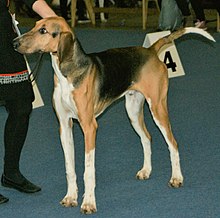Poitevin hound
| Poitevin | |||||||||||||||||||||||||
|---|---|---|---|---|---|---|---|---|---|---|---|---|---|---|---|---|---|---|---|---|---|---|---|---|---|
 | |||||||||||||||||||||||||
| Other names | Chien du Haut-Poitou | ||||||||||||||||||||||||
| Common nicknames | Haut-Poitou | ||||||||||||||||||||||||
| Origin | France | ||||||||||||||||||||||||
| |||||||||||||||||||||||||
| |||||||||||||||||||||||||
| Dog(domestic dog) | |||||||||||||||||||||||||
ThePoitevin,also known as theChien de Haut-Poitou,is abreedof Frenchscenthoundfrom the province ofPoitou,this predominantly pack hound was created in the 17th century tohunt wolves.
Characteristics
[edit]The Poitevin is a refined, athletic hound withsighthoundfeatures. In appearance it looks like a mixture of afoxhoundand agreyhound.[1]The Poitevin typically stands 60 to 72 centimetres (24 to 28 in) at thewithersand weighs 20.5 to 30.5 kilograms (45 to 67 lb). They have a flat, gently sloping skull; a long, narrow tapering muzzle; a slender, well-muscled neck; long, straight, heavily boned legs and a long tail.[2][3]The Poitevin's short coat is usually tricolour; all other breeds of tricolour hounds are sometimes described as having Poitevin heritage.[1][3][4]
The Poitevin is renowned for its speed, stamina, scenting abilities and melodious voice whilst hunting. Packs have been known to reach speeds of 56 kilometres per hour (35 mph) and to hunt for up to seven hours.[1][2][3][5]In his bookLa Vénerie,Pierre de Cossé Brissac, 12th Duke of Brissacsaid of the Poitevin "He is able to chase the quarry more than 7 hours. Because of his speed, the Poitevin's nickname is 'Greyhound among the French hounds'."[3][6]
While not shy, the Poitevin is known to be more aloof than many other hound breeds and does not adapt well when not kept in a pack environment.[3][5]
History
[edit]Poitevins descend from 12English Staghoundsthat were gifted to theDauphin of Francein 1692. Some of the offspring of these hounds were given to François de Larrye, Marquis of Haut-Poitou, who crossed them with local hounds. The offspring of this crossbreeding resulted in strong, athletic tricoloured hounds that the Marquis used to huntwolf,the first examples of the breed.[1][2][3][5]In addition to the Larrye pack, two other packs of Poitevins were bred, both named after their owners, theMontemboeufand Céris. These two packs were distinguished from the Larrye hounds in being bicoloured (orange and white), and both were considered inferior to the Larrye hounds.[1][3][5]
During theFrench Revolution,the fortunes of Poitevin suffered greatly. The then-Marquis de Larrye was beheaded in 1793 during theReign of Terror,and the Larrye pack was dispersed and the breed almost disappeared.[1][2][3][5]After the Revolution, two brothers, Emile and Arthur de la Besage ofMontmorillonwho lived in Poitou, sought to revive the breed. They collected whatever remaining Poitevins they could, including two from the Larrye pack, and reestablished a pack.[1][2][3][5]In 1842, disaster struck the de la Besage hounds, with an outbreak ofrabiesin the kennels nearly destroying the pack. The breed was revived by the importation ofEnglish Foxhounds,a carefully considered crossbreeding program was implemented, and within three generations the Foxhound influence was barely perceptible within the pack.[1][2]
The breed suffered greatly during theFirstandSecond World Wars,and at the end of the Second World War further outcrossings to English Foxhounds were necessary to reconstitute the breed.[1][3][5]
Modern use
[edit]Whilst the Poitevin was originally created to hunt thewolf,several packs are still maintained in France but today are used to huntboaranddeerin the traditions of the 'Grande Vénérie'.[1][3][4][5]The Poitevin was central to the development of the two most popular of France's packhound breeds, theGrand Anglo-Français TricoloreandChien Français Tricolore,as well as theAnglo-Français de Petite Vénerie.[1][2][5]
See also
[edit]References
[edit]- ^abcdefghijkMorris, Desmond(2001).Dogs: the ultimate dictionary of over 1,000 dog breeds.North Pomfret, VT: Trafalgar Square Publishing. pp. 84–85.ISBN1-57076-219-8.
- ^abcdefgFogle, Bruce(2009).The encyclopedia of the dog.New York: DK Publishing. pp. 160–161 & 187.ISBN978-0-7566-6004-8.
- ^abcdefghijkHörter, Rea (May 2010)."Poitevin -" Chien du Haut-Poitou ": A worker in the 'Grande Vénerie""(PDF).Canine Chronicle.Ocala, FL: Endeavor Publications. pp. 226–230.Retrieved12 December2014.
- ^abHancock, David (2014).Hounds: Hunting by scent.Ramsbury, Marlborough: The Crowood Press. pp. 128 & 148.ISBN978-1-84797-601-7.
- ^abcdefghiAlderton, David(2000).Hounds of the World.Shrewsbury: Swan Hill Press. pp. 93–94.ISBN1-85310-912-6.
- ^de Cossé Brissac, Pierre(1966).La Vénerie(in French). Paris: Del Duca.
